 Two days ago we held our second annual summer STEM event–this time focusing on the chemistry students and faculty who work in their labs all summer. On display were some of the 19thC prize essays in chemistry mentioned in the previous post, and half a dozen faculty and almost 30 students came by to delve into this collection, and see what was expected of a Trinity student studying chemistry more than a century ago. Those who broke free from their labs got a voucher for a free coffee at Peter B’s.
Two days ago we held our second annual summer STEM event–this time focusing on the chemistry students and faculty who work in their labs all summer. On display were some of the 19thC prize essays in chemistry mentioned in the previous post, and half a dozen faculty and almost 30 students came by to delve into this collection, and see what was expected of a Trinity student studying chemistry more than a century ago. Those who broke free from their labs got a voucher for a free coffee at Peter B’s.

Comments Off on Coffee for Chemists!
[Posted by Peter Rawson, Associate Curator of Archives & Manuscripts]
 The Chemical Prize Essay collection in the Trinity College Archives contains 327 chemical essays submitted by students at Trinity between 1858 and 1905.
The Chemical Prize Essay collection in the Trinity College Archives contains 327 chemical essays submitted by students at Trinity between 1858 and 1905.
These essays were submitted as part of a competition among students in to win the first place prize of $30 and the second place prize of $20.
The prize began in 1858 as a contest for seniors and became a junior prize in the mid-1880’s.
Essays were submitted to the Professor of Chemistry. These included Rev. Thomas R. Pynchon, Scoville Professor of Chemistry and Natural Science, 1854-1879; H. Carrington Bolton, Scoville Professor of Chemistry and Natural Science, 1880-1887; Robert B. Riggs (pictured here), Scoville Professor of Chemistry and Natural Science, 1888-1929.
 The assigned essay topic each year was predetermined, with topics concerning chemicals, new technology, plants, light, or the metric system. The essays are organized in alphabetical order of the essayists’ last names, and they include both the winning essays and the other contestants’ essays.
The assigned essay topic each year was predetermined, with topics concerning chemicals, new technology, plants, light, or the metric system. The essays are organized in alphabetical order of the essayists’ last names, and they include both the winning essays and the other contestants’ essays.
 Jarvis Lab (undated)
Jarvis Lab (undated)
Comments Off on Prize-winning Chemistry Essays
[Posted by Sally Dickinson, Associate Curator & Preservation Librarian]
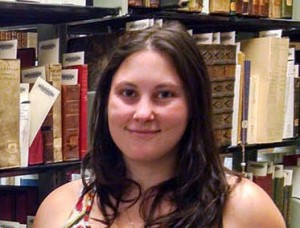 Gaia Cloutier ‘16 worked as a student assistant in the Watkinson Library this year. Gaia came to the job with some prior knowledge of books gained through taking Jonathan Elukin’s class on the Bible and History of the Book. She spent the year working on a special collection of books called the Cage collection. Gaia cleaned, inventoried, verified catalog records, and barcoded call flags which we place in the books (not on the book itself). This collection was originally the rare books collection of Trinity College. Because the books were enclosed within a metal gate, the area became known as “the Cage.” The books range from 17th century histories in multiple languages to books bound in parchment, to Japanese books with color woodblock prints. Some of the older tomes have issues that compromise their structure. Special boxes will be made for these volumes. Timing was perfect: Gaia finished the project the final week of classes at Trinity. Thank you, Gaia!
Gaia Cloutier ‘16 worked as a student assistant in the Watkinson Library this year. Gaia came to the job with some prior knowledge of books gained through taking Jonathan Elukin’s class on the Bible and History of the Book. She spent the year working on a special collection of books called the Cage collection. Gaia cleaned, inventoried, verified catalog records, and barcoded call flags which we place in the books (not on the book itself). This collection was originally the rare books collection of Trinity College. Because the books were enclosed within a metal gate, the area became known as “the Cage.” The books range from 17th century histories in multiple languages to books bound in parchment, to Japanese books with color woodblock prints. Some of the older tomes have issues that compromise their structure. Special boxes will be made for these volumes. Timing was perfect: Gaia finished the project the final week of classes at Trinity. Thank you, Gaia!
Comments Off on Thanks and Good Luck!
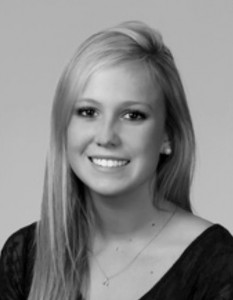 I am pleased to announce that May Collins P. Woollcott ’16 is this year’s awardee of the South Beach Writing Residency, offered by the family of Hyam Plutzik ’32.
I am pleased to announce that May Collins P. Woollcott ’16 is this year’s awardee of the South Beach Writing Residency, offered by the family of Hyam Plutzik ’32.
Originally from Atlanta, GA, May is an English major with a focus on creative writing. This semester she is completing a poetry thesis under Professor Clare Rossini, poet and Artist-in-Residence at Trinity College. Upon graduation, May will be moving to Boston to work in publishing. She hopes to attend an MFA program in the coming years.
The family of Hyam Plutzik (Trinity ’32) provides an annual residency (for five years) in South Beach in the Betsy Writer’s Room to a graduating senior with outstanding talent in the literary arts. The award is bestowed as part of the graduation program (Honors Day). This residency comes with a $500 travel stipend, six days lodging, and a per diem of $50. During the residency, which can happen anytime during the award year, the recipient will be invited to participate in an Arts Salon to share her work with the community.
Comments Off on Third Annual Writer’s Residency
 This morning a student and I visited Papermania in downtown Hartford–I’ve been meaning to go for years, and I definitely am glad I went. Well over 100 dealers “from Florida to Canada” (but mainly from the northeast) brought a great array of STUFF to the fair–lots of ephemera of course, and books, but also posters, postcards, photos, and all manner of artifacts from scientific instruments to pop culture bobbles and doodads…I especially liked a little stamping kit for creating musical scores.
This morning a student and I visited Papermania in downtown Hartford–I’ve been meaning to go for years, and I definitely am glad I went. Well over 100 dealers “from Florida to Canada” (but mainly from the northeast) brought a great array of STUFF to the fair–lots of ephemera of course, and books, but also posters, postcards, photos, and all manner of artifacts from scientific instruments to pop culture bobbles and doodads…I especially liked a little stamping kit for creating musical scores.
My student bought one small thing for himself, and I bought several things for the library, and made a good many connections. Of particular interest is a collection and archive (3 boxes) related to the Boston scholar-printer Daniel Berkeley Updike, of the Merrymount Press, which will be delivered to the library soon; also a series of historical fiction for juveniles, and another batch of 19th century American almanacs for our growing collection.
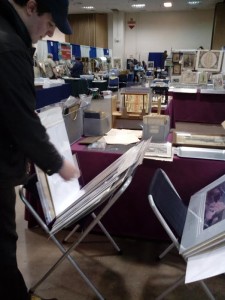
One of the items I wanted to buy but didn’t (we’ll see!) was a large broadside of recipes, printed in Hartford and hand-colored:

Comments Off on Papermania!
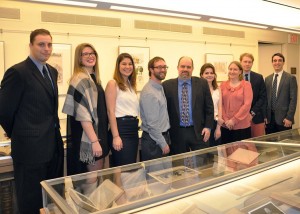 Last night we had over 50 people attend the opening of “Pieces of Eight,” the collective title of a showcase of eight separate student exhibitions in the Watkinson Library, which will run through June 30, 2016. This is the fifth annual such showcase of student exhibitions, and the turnout of faculty, students, parents and staff was very gratifying.
Last night we had over 50 people attend the opening of “Pieces of Eight,” the collective title of a showcase of eight separate student exhibitions in the Watkinson Library, which will run through June 30, 2016. This is the fifth annual such showcase of student exhibitions, and the turnout of faculty, students, parents and staff was very gratifying.
The exhibits and their curators are as follows:
Handmaid to History: What is Antiquarianism? / Elizabeth Askren ‘17
“Following the Light of the Sun, We Left the Old World”: The Dawn of Printing / Alec Buffamonte ‘17
An Uneven Playing Field: Sports and Social Classes in Britain / Marcus Cinotti, graduate student
Who You Gonna Call? Ghost Hunters from 1860-1960 / Hunter Drews ‘16
Bluejackets & Devil Dogs: U.S. Navy and Marine Corps Recruiting Posters from the Great War / Jordan Finning, graduate student
From Ragtime to Rock & Roll: Music Culture at Trinity College / Matthew Nazarian, graduate student
Victorian Ladies Leave the Sidelines: Women in Sports, 1860-1890 / Rosangelica Rodriguez, graduate student
Infant Doping and the Opium Imagination / Sarah St. Germain, graduate student



Comments Off on Opening of student shows (“Pieces of Eight”)
 Members of the current Tripod staff were able to benefit from the wisdom of several alumni who worked on the paper in their time at Trinity, and came in today to look at the exhibition “Ten Decades of the Tripod.”
Members of the current Tripod staff were able to benefit from the wisdom of several alumni who worked on the paper in their time at Trinity, and came in today to look at the exhibition “Ten Decades of the Tripod.”
Ben Barber ’65 held forth to the students about the importance of editing, especially when the current editor revealed that many student contributors were offended by changes made to their copy.
“That’s journalism,” said Barber, a professional journalist for decades who currently writes for the Huffington Post, and who made it clear that every writer needs an editor. Barber left Trinity and “became a hippie,” as he says, roving through India and Thailand for ten years, writing poetry and selling stories to newspapers back in the US. He spoke at length with several students about writing and reporting.
 Robert Cockburn ’90, who also serves on the Board of Fellows, talked animatedly with the students and other alumni (Pat Sclafani ’83, and Patty Hooper Kelley ’82) and told stories of their days with the paper. A bit later Marybeth (Callan) Serdechny ’83 and Que (Ho) Witik ’83 dropped in and reminisced about the classmates they saw in the stacks of Tripods from the 1980s.
Robert Cockburn ’90, who also serves on the Board of Fellows, talked animatedly with the students and other alumni (Pat Sclafani ’83, and Patty Hooper Kelley ’82) and told stories of their days with the paper. A bit later Marybeth (Callan) Serdechny ’83 and Que (Ho) Witik ’83 dropped in and reminisced about the classmates they saw in the stacks of Tripods from the 1980s.
Another alumnus, Dan Kelman ’76, who served on the Tripod as a freelance photographer in the early 1970s, pointed out many of his pics and reminisced about his friend Dave Levin ’75, who went on to shoot photos for Sports Illustrated.
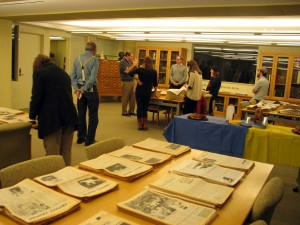
Comments Off on Homecoming visitors
 Prof. Dario Del Puppo brought his First-Year Seminar on “Food, Fitness & Self Discovery” into the Watkinson for rather non-intuitive reasons, given the title of his course, until you understand that he routinely teached Italian literature from the medieval and Renaissance periods, and then the reasons become clearer.
Prof. Dario Del Puppo brought his First-Year Seminar on “Food, Fitness & Self Discovery” into the Watkinson for rather non-intuitive reasons, given the title of his course, until you understand that he routinely teached Italian literature from the medieval and Renaissance periods, and then the reasons become clearer.
In any case, the students were immediately engaged and curious about the 11 items Dario chose to show them–from an edition of Dante’s Commedia published in 1484, a 1523 edition (almost pocket-sized) of Vitruvius’s De Architectura, and the 1632 edition of Galileo’s Dialogo.
There were lots of questions, and we looked at watermarks, bookworm damage, woodcut and copperplate illustrations, initial letters, and marbled paper–and one student even discovered a fragment of a medieval manuscript as part of the binding waste . . . . these sessions are always exciting when the students are engaged!
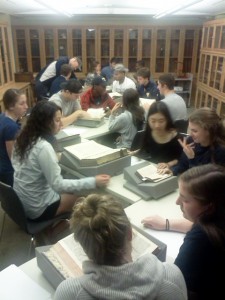
Comments Off on Food & Fitness…in the Renaissance???
This week saw a rare happening in the Watkinson: two presentations using the exact same materials for separate classes at separate institutions!
 On Monday night, profesor Scott Gac (Trinity) brough his HIST 354 class in to look at materials related to slavery in the Watkinson, which included a set of slave shackles recently donated to us, two manumission documents, and two bills of sale for slaves.
On Monday night, profesor Scott Gac (Trinity) brough his HIST 354 class in to look at materials related to slavery in the Watkinson, which included a set of slave shackles recently donated to us, two manumission documents, and two bills of sale for slaves.
 On Tuesday night, professors Bryan Sinche and Sarah Senk (University of Hartford) brought the students in a Senior Capstone Course to look at the very same items, with the addition of published slave narratives and publications of the American Colonization Society–including our very fragile issues of The Liberia Herald.
On Tuesday night, professors Bryan Sinche and Sarah Senk (University of Hartford) brought the students in a Senior Capstone Course to look at the very same items, with the addition of published slave narratives and publications of the American Colonization Society–including our very fragile issues of The Liberia Herald.
Comments Off on A teaching two-fer
 On Wednesday (the eve of Shakespeare’s birthday) the Watkinson (producer) paired up with volunteers from Dan Lloyd’s “Shakespeare as Philosopher” class (cast) and area teaching artist Christin Goff (Director) to perform a staged reading of King John.
On Wednesday (the eve of Shakespeare’s birthday) the Watkinson (producer) paired up with volunteers from Dan Lloyd’s “Shakespeare as Philosopher” class (cast) and area teaching artist Christin Goff (Director) to perform a staged reading of King John.
 The players performed to a small but dedicated audience–augmented by a few floaters after intermission, who doubtless came to see what all the fuss was about. The production was augmented by inter-scene and intermission music, live bongo drums (for dramatic affect), and projected slides which provided a visual gloss, of sorts, to the action, which at times can be unclear (this is not one of the more well-known plays). However, the text was edited by Ms. Goff for the performance, which helped the flow and pacing of the play, and the name-cards displayed when a character was speaking also helped.
The players performed to a small but dedicated audience–augmented by a few floaters after intermission, who doubtless came to see what all the fuss was about. The production was augmented by inter-scene and intermission music, live bongo drums (for dramatic affect), and projected slides which provided a visual gloss, of sorts, to the action, which at times can be unclear (this is not one of the more well-known plays). However, the text was edited by Ms. Goff for the performance, which helped the flow and pacing of the play, and the name-cards displayed when a character was speaking also helped.
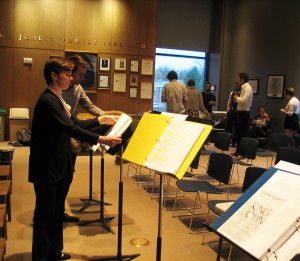
 This was the first in what we plan will be a series of productions of Shakespeare sponsored by the Watkinson, to draw attention to the recently acquired and restored “2nd Folio” (the second edition of the first publication of the complete plays of Shakespeare, printed in 1632).
This was the first in what we plan will be a series of productions of Shakespeare sponsored by the Watkinson, to draw attention to the recently acquired and restored “2nd Folio” (the second edition of the first publication of the complete plays of Shakespeare, printed in 1632).
We thank professor Lloyd & his class for their hard work!

Comments Off on King John in the Library
 The Chemical Prize Essay collection in the Trinity College Archives contains 327 chemical essays submitted by students at Trinity between 1858 and 1905.
The Chemical Prize Essay collection in the Trinity College Archives contains 327 chemical essays submitted by students at Trinity between 1858 and 1905.
 The assigned essay topic each year was predetermined, with topics concerning chemicals, new technology, plants, light, or the metric system. The essays are organized in alphabetical order of the essayists’ last names, and they include both the winning essays and the other contestants’ essays.
The assigned essay topic each year was predetermined, with topics concerning chemicals, new technology, plants, light, or the metric system. The essays are organized in alphabetical order of the essayists’ last names, and they include both the winning essays and the other contestants’ essays.






















